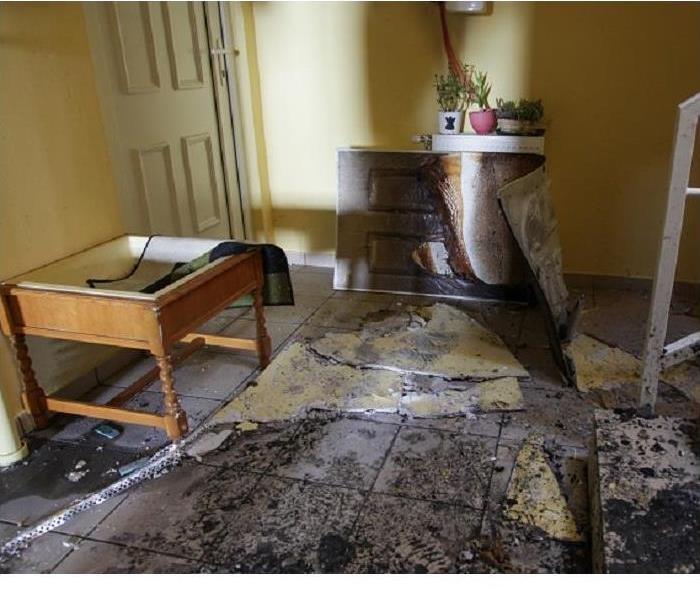What Obstacles Prevent Successful Cleaning of Belmont Homes After a Fire
6/24/2020 (Permalink)
Understanding factors that affect cleaning fire loss effects can make the restoration of your fire-damaged property more efficient and cost-effective
Cleaning is a vital component to fire loss recovery in your Belmont home, and with so many types of actions that this term could embody, some of these approaches happen as soon as our SERVPRO technicians arrive. From the removal of fire debris on the flooring throughout the residence to removing surface soot and odors, we have numerous obstacles that stand between our qualified professionals and restoring your property to preloss condition.
When it comes to addressing fire damage in your Belmont residence, we rely first on the qualified opinions and findings of our project manager's preliminary job scoping effort. This evaluation indicates which areas of your home require the most urgent attention, contents that might have become damaged during the structure fire, and what personnel and equipment will be necessary during the restoration process. With no loss incidents being the same, this job scoping narrows the field of appropriate corrective actions and shows responding technicians which surfaces and contents require cleaning.
What Cleaning Challenges Exist After a Fire Loss?
With the team that has seen many fire loss incidents since we first opened our doors, we have a confident approach regarding what works and what does not. Cleaning up fire debris throughout the property is one of the immediate actions that our team can take to reduce compromising conditions like soot and odor circulation. There are often many obstacles preventing the successful cleaning of damaged elements and content throughout the property after a fire loss. Generally, these can get broken down into four primary categories:
- Type of Material
- Heat and Moisture Present
- Smoke Residues Present
- Air Flow
How Can the Fire or the Materials Affected Impact Cleanup?
Understanding these potential problems can help our technicians to offer suitable alternatives to provide the same expected level of recovery and restoration after a disaster. Much of the concerns that exist involve the type of material impacted by the spreading fire loss effects in Belmont. The surfaces affected by residues, soiling, and odors can be any within the active fire path before extinguishment. In most house fires, conditions can continue to get worse until the appropriate restorative actions get taken. Cleaning up after a fire loss is not without possible hurdles, however. while hundreds of situations could slow or stall fire restoration cleaning, these are often the most common:
- Age of Surface – The age of the material affected has a substantial correlation with the ease of cleaning. It is not unreasonable to suggest the older a surface has become, the harder it becomes to clean. This principle can also be for wall services where paint has begun to deteriorate and allow the surface to be more porous overall.
- The Heat of the Fire – How hot the fire burns can often be an indicator of the difficulty our technicians will have with cleaning services. The hotter the fire, the more that affected surfaces expand and absorb migrating threats like smoke and odors. Excessive heat can also lead to charring and melting, which renders cleaning inefficient and requires refinishing instead.
- Type of Material Burned – The type of material affected has a direct impact on the challenge of cleaning to come. Natural materials often leave behind a dryer residue that is easier to clean, synthetic materials like plastic can leave a thicker, more challenging residue to contend with when we arrive.
- Air Pressure – The presence of heat in the air causes expansion. Rising temperatures can lead to an expanse of air that forces soot into crevices and cracks under substantial pressure.
What Are the Most Effective Post-Fire Cleaning Methods?
While you might not realize how many actions and tasks can fall under the heading of cleaning after a fire loss incident, there are specific approaches that have proven more effective than others when it comes to removing residues and odors. Fire loss recovery in your home is more efficient and cost-effective because of practices like:
- Agitative Cleaning
- Soda Blasting
- Wipe Cleaning
- Emulsification
There is no universal solution when it comes to cleaning up your home after a fire loss incident. When disaster strikes, you can trust in the fast and reliable response of our SERVPRO of The Lakes Region team to help. We have efficient equipment and extensive education in post-fire cleanup to make it, "Like it never even happened." Give us a call today at (603) 527-2518.






 24/7 Emergency Service
24/7 Emergency Service
